Peru's Path to Progress: Harnessing Innovation and Renewable Energy to Tackle the Drug Trade
The state is undertaking development activities for creating innovative technology to address the surge in coca cultivation and the drug trade in Peru's remote regions, emphasizing the potential of renewable energy and collaboration to create sustainable alternatives.
In recent years, there has been a surge in technological advancements that have revolutionized various industries. From the field of medicine to transportation and communication, these groundbreaking innovations have made our lives easier and more efficient.
One such area where human talent has shined is in the field of renewable energy. The need for clean and sustainable sources of power has become more pressing than ever before, and scientists and engineers have risen to the challenge.
Solar power, wind power, and hydropower are just a few examples of the renewable energy sources that have gained popularity in recent years. In Peru, a country known for its immense natural beauty and diverse ecosystem, the cultivation of coca has become a major issue.
The coca plant, which is used to produce cocaine, has seen a significant increase in farming in remote regions such as Ucayali. This surge in coca cultivation has raised concerns not only for the environment but also for the Indigenous communities who call these areas home.
The drug trade that has taken hold in these regions has not only had a devastating impact on the environment but also on the people living there. Indigenous tribes such as the Amahuaca and Asheninka have reported an increase in smuggling activities, with drug traffickers encroaching on their lands and attempting to recruit their youth for illicit purposes.
The lack of state security and presence along Peru's borders has created a haven for criminal organizations to operate. With minimal efforts to eradicate coca crops and a limited ability to monitor and control the flow of drugs, these criminal networks have flourished. It is within this context that the innovative potential of human talent becomes crucial.
Peru, known for its rich history and culture, is also home to talented individuals who possess expertise in various fields. These individuals have the potential to contribute to solving the issues caused by the drug trade and the surge in coca cultivation.
Scientists, researchers, and entrepreneurs can come together to develop sustainable alternatives to coca farming. For example, the implementation of renewable energy technologies in these remote regions can provide alternative sources of income for the local communities.
Solar panels and wind turbines can generate clean and sustainable energy, creating employment opportunities and reducing the reliance on coca cultivation. Additionally, initiatives focused on education and skill development can empower the Indigenous youth, offering them an alternative path away from drug-related activities.
It is essential for the Peruvian government and international organizations to step up their efforts in supporting these innovative solutions. By providing funding and resources, they can facilitate the development and implementation of these projects.
Furthermore, collaboration between the government, Indigenous communities, and the private sector can ensure that these initiatives are sustainable and have a lasting impact. In conclusion, Peru is facing significant challenges due to the surge in coca cultivation and the drug trade in its remote regions.
However, the country is also home to talented individuals and innovative thinkers who have the potential to address these issues. By harnessing human talent and promoting sustainable alternatives, Peru can work towards a future that is free from the devastating effects of the drug trade while preserving its natural beauty and protecting the rights and well-being of its Indigenous communities.




